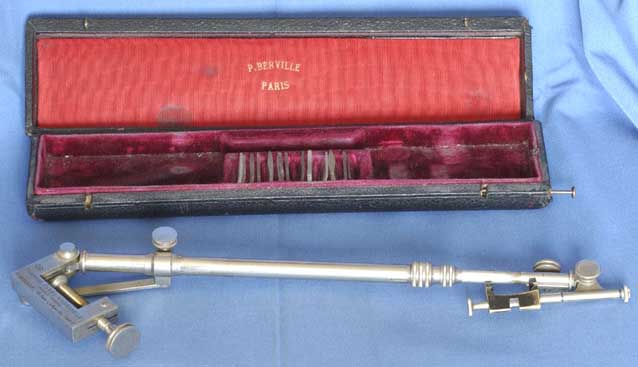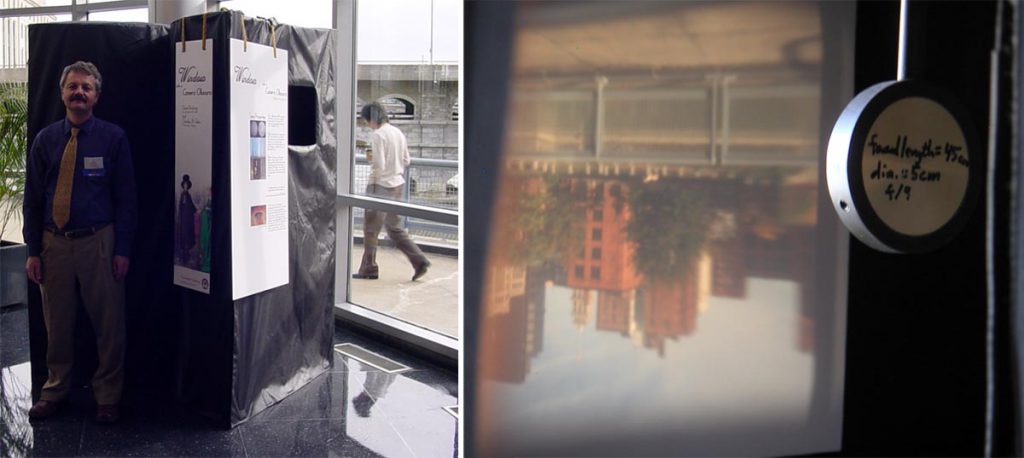General Questions
Where can I buy a concave mirror?
The cosmetics counter at any drugstore will have a two-sided “makeup mirror,” with a standard flat mirror on one side and a concave enlarging mirror on the other. The most common seem to be about 5″ (13 cm) in diameter, and sell for only a few dollars (mirrors advertised as “high magnification” also can be used, although they sell for ~$10). Those work fine, although the quality of the image they produce is degraded by the fact they are so large. A large concave mirror produces an image that is brighter, but fuzzier, than a small one. However, it is very easy to reduce the effective size of a mirror by simply sticking a paper “donut” over the face of it. Smaller diameter concave mirrors also are sold in some stores, intended for carrying in purses. For those who want to experiment with a variety of focal lengths, shorter focal length concave mirrors can be found in auto parts stores sold as accessory convex rear-view mirrors. The ones I have found come in cheap aluminum mounts that are easy to pry away from the mirror. After doing so the opaque protective coating on the concave side needs to be removed with a solvent such as acetone (fingernail polish remover).
Where can I buy a camera lucida?
Although it seems no new ones had been manufactured by anyone for some years, very recently one has come on the market with what the manufacturer says is a revised optical design. I don’t have any experience with this particular one, but you can find information about it at www.camera-lucida.com. Also, used ones of a type manufactured for many years in France regularly appear on eBay (Chambre Claire Universelle, Claire-vue, and Léon are three of the more common names under which these are listed, although variations, such as brass or nickel-plate, add to the choices). Below is a typical French-made (by Berville of Paris) camera lucida of the type that frequently appears on eBay. This one is nickel-plated, but polished brass is another variation. Note the twelve lenses in slots in the case, all of which are needed in order to work with a full range of image magnifications.

Without taking the time to describe the theory of operation of a camera lucida, I note that if you buy one of these it is very important that it comes with a complete set of supplementary lenses (most commonly, 12 such lenses). As for price, you can expect to pay over $300 on eBay for one in good condition. Also, do not buy one that is intended for use with a microscope, since it will not be useful as a “standard” artist’s tool. Page 29 of Hockney’s book shows the appropriate type of camera lucida in operation.
Where can I buy a camera obscura?
If you read the discussion in the section on Scientific and Technical Questions you will see that a camera obscura is something to make, not something to buy, since all that is needed is a lens (or concave mirror) and some cloth to minimize extraneous light. Several years ago my daughter Amelia Falco, now an architect in New York, designed a portable camera obscura that is small enough to travel as checked luggage.

Left: My daughter Amelia Falco, an architecture student at the time (now an architect in New York), designed this portable camera obscura for us to use for demonstrations. Disassembled, it fits into a case designed for carrying a set of golf clubs as checked-in airline luggage, assembles in 15 minutes, and occupies floor space of 4×4 ft. (125×125 cm). The shipping case also holds a tripod and light source (with 120 V and 220 V bulbs) for use at night or on gloomy winter days. The opening through which the concave mirror captures the image is visible on the camera obscura’s wall at the right. Here it is set up at a meeting of the Optical Society of America in Rochester, New York.
Right: An image of downtown Rochester projected by the home-made brass mirror that is also visible in this photograph. It is easy to see from this photograph how bright and sharp projected images are, even though the piece of optics is so simple.
You will quickly discover that the focal length of the lens affects the magnification of the image, with longer focal length lenses resulting in larger images. Inexpensive lenses appropriate for use in your first camera obscura can be found in the form of magnifying glasses for enlarging text. Plastic ones are less expensive and lighter than glass ones, and work perfectly well for this purpose.
How much equipment do I need to project an image myself?
You only need a $3 “makeup mirror” and a somewhat darkened room. The bathroom in many houses is ideal. With the lights off to minimize the ambient level in the room hold your mirror about 18 inches (45 cm) from the window, “aiming” it at the the vertical edge of the window frame (be sure you have the concave, not the flat, side facing the window). You should immediately see a bright area on the wall adjacent to the window frame, with the blue of the sky at the bottom, and the green of the outside vegetation at the top. Move the mirror a few inches toward and away from the window until you find the distance that gives you a sharp image.
Rather than a concave mirror, instead you can use a refractive lens, such as a magnifying glass. In this case the image will be formed on the wall opposite to the window, rather than on the wall next to the window. Start with your magnifying glass about 12 inches (30 cm) from the wall. Again, the blue of the sky will be at the bottom of the projected image, and the green of the vegetation at the top.

